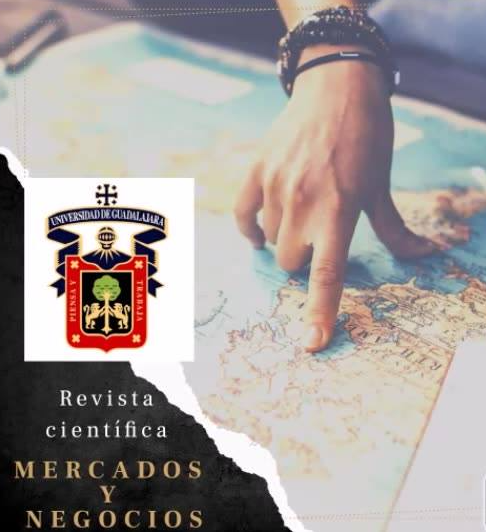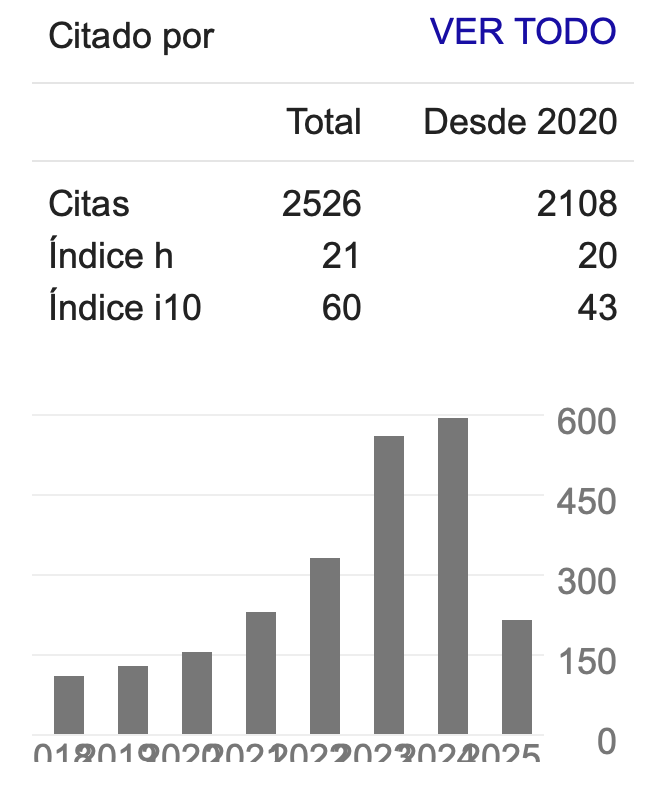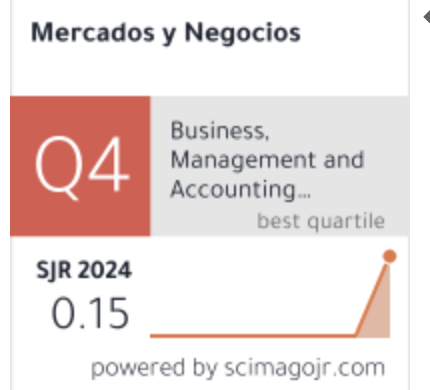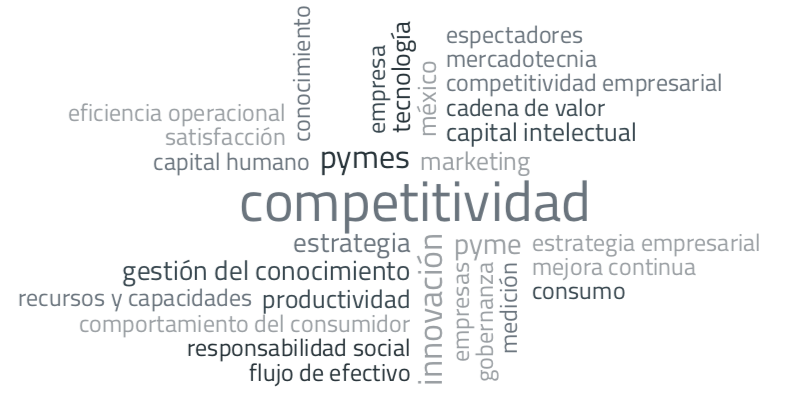Adaptability of a Business and Superior Performance: Triad Model of Dynamic Capabilities
DOI:
https://doi.org/10.32870/myn.vi52.7731Keywords:
Business Adaptability, Superior Performance, Dynamic Capabilities, CompetitivenessAbstract
This study examines the relationship between business adaptability and superior performance. The researchers used Exploratory Factor Analysis and Kruskal-Wallis statistics to analyze data from a survey of 227 companies associated with a University Center. The study found that the Triad Model of Dynamic Capabilities, which includes Sense, Seize, and Transform components, explained 78.38% of the variance in business adaptability. The findings confirm the importance of Sense, Seize, and Transform capabilities in sustaining competitive advantage, as demonstrated by the observed superior performance of the organizations. The originality of the paper lies in identifying higher-order capabilities associated with business adaptability in organizations across different sectors.References
Alshanty, A. M., & Emeagwali, O. L. (2019). Market-sensing capability, knowledge creation and innovation: The moderating role of entrepreneurial-orientation. Journal of Innovation & Knowledge, 4(3), 171–178. http://doi.org/10.1016/j.jik.2019.02.002
Almaraz, A. (2022). Small and Medium Enterprises in Mexico and the Craft Beer Sector in Baja California: Dynamic Capabilities, Culture, and Innovation. Journal of Evolutionary Studies in Business, 7(1), 166–203. http://doi.org/10.1344/jesb2022.1.j102
Akter, S., Gunasekaran, A., Wamba, S. F., Babu, M. M., & Hani, U. (2020). Reshaping competitive advantages with analytics capabilities in service systems. Technological Forecasting and Social Change, 159, 120180. http://doi.org/10.1016/j.techfore.2020.120180
Al-Matari, A. S., Amiruddin, R., Aziz, K. A., & Al-Sharafi, M. A. (2022). The Impact of Dynamic Accounting Information System on Organizational Resilience: The Mediating Role of Business Processes Capabilities. Sustainability, 14(9), 4967. http://doi.org/10.3390/su14094967
Apascaritei, P., & Elvira, M. M. (2022). Dynamizing human resources: An integrative review of SHRM and dynamic capabilities research. Human Resource Management Review, 32(4), 100878. http://doi.org/10.1016/j.hrmr.2021.100878
Araújo, C. C. S. de, Pedron, C. D., & Bitencourt, C. (2018). Identifying and assessing the scales of dynamic capabilities: A systematic literature review. Revista de Gestão, 25(4), 390–412. http://doi.org/10.1108/REGE-12-2017-0021
Arend, R. J., & Bromiley, P. (2009). Assessing the dynamic capabilities view: Spare change, everyone? Strategic Organization, 7(1), 75-90. http://doi.org/10.1177/1476127008100132
Andersén, J. (2021). Resource orchestration of firm-specific human capital and firm performance—The role of collaborative human resource management and entrepreneurial orientation. The International Journal of Human Resource Management, 32(10), 2091–2123. http://doi.org/10.1080/09585192.2019.1579250
Arndt, F., & Pierce, L. (2018). The behavioral and evolutionary roots of dynamic capabilities. Industrial and Corporate Change, 27(2), 413–424. http://doi.org/10.1093/icc/dtx042
Arndt, F., Galvin, P., Jansen, R. J. G., Lucas, G. J. M., & Su, P. (2022). Dynamic capabilities: New ideas, microfoundations, and criticism. Journal of Management & Organization, 28(3), 423–428. http://doi.org/10.1017/jmo.2022.57
Barros-Contreras, I., Palma-Ruiz, J. M., & Torres-Toukoumidis, A. (2021). Organizational Capabilities for Family Firm Sustainability: The Role of Knowledge Accumulation and Family Essence. Sustainability, 13(10), 5607. http://doi.org/10.3390/su13105607
Bayighomog, S. W., Shamout, M. D., Harazneh, I., & Abubakar, A. M. (2020). Market-Sensing Capability, Innovativeness, Brand Management Systems, Market Dynamism, Competitive Intensity, and Performance: An Integrative Review. Journal of the Knowledge Economy, 11(2), 593–613.
Belitski, M., & Mariani, M. (2023). The effect of knowledge collaboration on business model reconfiguration. European Management Journal, 41(2), 223-235. http://doi.org/10.1016/j.emj.2022.02.006
Berndt, A. E. (2020). Sampling Methods. Journal of Human Lactation, 36(2), 224-226. http://doi.org/10.1177/0890334420906850
Bortoluzzi, B., Carey, D., McArthur, J. J., & Menassa, C. (2021). Measurements of workplace productivity in the office context: A systematic review and current industry insights [Other]. Toronto Metropolitan University. Journal contribution. http://doi.org/10.32920/14638242
Bogers, M., Chesbrough, H., Heaton, S., & Teece, D. J. (2019). Strategic Management of Open Innovation: A Dynamic Capabilities Perspective. California Management Review, 62(1), 77–94. http://doi.org/10.1177/0008125619885150
Camisón-Zornoza, C., Forés-Julián, B., Puig-Denia, A., & Camisón-Haba, S. (2020). Effects of ownership structure and corporate and family governance on dynamic capabilities in family firms. International Entrepreneurship and Management Journal, 16(4), 1393-1426. http://doi.org/10.1007/s11365-020-00675-w
Cristofaro, M., & Lovallo, D. (2022). From framework to theory: An evolutionary view of dynamic capabilities and their microfoundations. Journal of Management & Organization, 28(3), 429–450. http://doi.org/10.1017/jmo.2022.46
Chen, G. (2005). A Framework for Conducting Multi-level Construct Validation. In Yammarino, F.J. & Dansereau, F. (Ed.) Multi-level Issues in Organizational Behavior and Processes (Research in Multi-Level Issues, Vol. 3), Emerald Group Publishing Limited, Leeds, pp. 273-303. https://doi.org/10.1016/S1475-9144(04)03013-9
Chen, Y. (Ken), Coviello, N., & Ranaweera, C. (2021). When change is all around: How dynamic network capability and generative NPD learning shape a firm’s capacity for major innovation. Journal of Product Innovation Management, 38(5), 574–599. http://doi.org/10.1111/jpim.12595
Correia, R. J., Días, J. G., & Teixeira, M. S. (2021). Dynamic capabilities and competitive advantages as mediator variables between market orientation and business performance. Journal of Strategy and Management, 14(2), 187-206. http://doi.org/10.1108/JSMA-12-2019-0223
CUCEA (2021). Programa de Prácticas Profesionales. Convenios específicos de prácticas profesionales. Universidad de Guadalajara.
CUCEA (2022). Programa de Prácticas Profesionales. Convenios específicos de prácticas profesionales. Universidad de Guadalajara.
Doz, Y. (2020). Fostering strategic agility: How individual executives and human resource practices contribute. Human Resource Management Review, 30(1), 100693. https://doi.org/10.1016/j.hrmr.2019.100693
Eisenhardt, K. M., & Martín, A. M. (2000). Dynamic capabilities: What are they? Strategic Management Journal, 21, 1105–1121.
Fainshmidt, S., Pezeshkan, A., Lance Frazier, M., Nair, A., & Markowski, E. (2016). Dynamic Capabilities and Organizational Performance: A Meta-Analytic Evaluation and Extension: Dynamic Capabilities and Organizational Performance. Journal of Management Studies, 53(8), 1348–1380. http://doi.org/10.1111/joms.12213
Foss, N. J. (2011). Micro-foundations for the resource-based view? Journal of Management, 37, 1413–1428. http://doi.org/10.1177/0149206310390218
Foss, N. J., & Lindenberg, S. (2013). Microfoundations for Strategy: A Goal-Framing Perspective on the Drivers of Value Creation. Academy of Management Perspectives, 27(2), 85–102. http://doi.org/10.5465/amp.2012.0103
Fornell, C., & Larcker, D. F. (1981). Evaluating structural equation models with unobservable variables and measurement error. Marketing Research, 18(1), 39–50.
Friedman, Y., Carmeli, A., & Tishler, A. (2016). How CEOs and TMTs Build Adaptive Capacity in Small Entrepreneurial Firms: Adaptive Capacity in Small Firms. Journal of Management Studies, 53(6), 996–1018. http://doi.org/10.1111/joms.12184
Frogeri, R. F., Portugal Júnior, P. D. S., Piurcosky, F. P., Sanacato, V., Calle, J. L. D., Gazzola, S. B., & Oliveira, F. F. D. (2022). Dynamic Ambidexterity: Proposal of a Theoretical and Hypothetical Model. Revista de Administração Contemporânea, 26(6). http://doi.org/10.1590/1982-7849rac2022210088.en
Furnival, J., Boaden, R., & Walshe, K. (2019). A dynamic capabilities view of improvement capability. Journal of Health Organization and Management, 33(7/8), 821–834. http://doi.org/10.1108/JHOM-11-2018-0342
Gaviria-Marin, M., Matute-Vallejo, J., & Baier-Fuentes, H. (2021). The effect of ICT and higher-order capabilities on the performance of Ibero-American SMEs. Computational and Mathematical Organization Theory, 27(4), 414–450. http://doi.org/10.1007/s10588-021-09333-0
Gelhard, C., von Delft, S., & Gudergan, S. P. (2016). Heterogeneity in dynamic capability configurations: Equifinality and strategic performance. Journal of Business Research, 69(11), 5272–5279. http://doi.org/10.1016/j.jbusres.2016.04.124
Gibbons, J. D., & Chakraborti, S. (2011). Nonparametric Statistical Inference (5a ed.). Taylor & Francis Group.
Gjoni, A., Çela, S., Mlouk, A., & Marku, G. (2022). Determinants of financial performance in Albanian economic entities, case of construction industry in Albania. Wseas Transactions on Business and Economics, 19, 453–461. http://doi.org/10.37394/23207.2022.19.41
Gregory, G. D., Ngo, L. V., & Karavdic, M. (2017). Developing e-commerce marketing capabilities and efficiencies for enhanced performance in business-to-business export ventures. Industrial Marketing Management, 78, 146–157. http://doi.org/10.1016/j.indmarman.2017.03.002
Helfat, C. E. (2007). Dynamic capabilities: Understanding strategic change in organizations. Blackwell Pub.
Helfat, C. E., & Martin, J. A. (2015). Dynamic Managerial Capabilities: Review and Assessment of Managerial Impact on Strategic Change. Journal of Management, 41(5), 1281–1312. http://doi.org/10.1177/0149206314561301
Hernández-Linares, R., Kellermanns, F. W., & López-Fernández, M. C. (2020). Dynamic capabilities and SME performance: The moderating effect of market orientation. Journal of Small Business Management, 59(1), 162–195. http://doi.org/10.1111/jsbm.12474
INEGI. (2022). Demografía de los establecimientos MiPyME en el contexto de la pandemia por COVID-19. Comunicado de prensa Núm. 335/22.
Kaur, V. (2019). Knowledge-Based Dynamic Capabilities: The Road Ahead in Gaining Organizational Competitiveness. Springer. http://doi.org/10.1007/978-3-030-21649-8
Khan, O., Daddi, T., & Iraldo, F. (2020). Microfoundations of dynamic capabilities: Insights from circular economy business cases. Business Strategy and the Environment, 29(3), 1479–1493. http://doi.org/10.1002/bse.2447
Kump, B., Engelmann, A., & Kessler, A. (2018). Toward a dynamic capabilities scale: Measuring organizational sensing, seizing, and transforming capacities. Industrial and Corporate Change. http://doi.org/10.1093/icc/dty054
Kurtmollaiev, S. (2020). Dynamic Capabilities and Where to Find Them. Journal of Management Inquiry, 29(1), 3–16. http://doi.org/10.1177/1056492617730126
Leemann, N., Kanbach, D., & Stubner, S. (2021). Breaking the Paradigm of Sensing, Seizing, and Transforming—Evidence from Axel Springer. Journal of Business Strategies, 38(2), 95–124. http://doi.org/10.54155/jbs.38.2.95-124
Leemann, N., & Kanbach, D. K. (2022). Toward a taxonomy of dynamic capabilities – a systematic literature review. Management Research Review, 45(4), 486–501.
Le, P. B., & Lei, H. (2019). Determinants of innovation capability: The roles of transformational leadership, knowledge sharing and perceived organizational support. Journal of Knowledge Management, 23(3), 527–547. http://doi.org/10.1108/JKM-09-2018-0568
Leví-Mangin, J. P., & Varela-Mallou, J. (2003). Analisis multivariable para las Ciencias Sociales. Pearson Education
Lin, T.-C., Sheng, M. L., & Jeng Wang, K. (2020). Dynamic capabilities for smart manufacturing transformation by manufacturing enterprises. Asian Journal of Technology Innovation, 28(3), 403–426. http://doi.org/10.1080/19761597.2020.1769486
Linden, G., & Teece, D. J. (2018). Remarks on Pisano: “Toward a prescriptive theory of dynamic capabilities.” Industrial and Corporate Change, 27(6), 1175–1179. http://doi.org/10.1093/icc/dty047
Lloret-Segura, S., Ferreres-Traver, A., Hernández-Baeza, A., & Tomás-Marco, I. (2014). El análisis factorial exploratorio de los ítems: Una guía práctica, revisada y actualizada. Anales de Psicología, 30(3), 1151-1169. http://doi.org/10.6018/analesps.30.3.199361
Markovich, A., Raban, D. R., & Efrat, K. (2022). Tailoring competitive information sources to the sequence of dynamic capabilities. Journal of Management & Organization, 28(3), 480–501. http://doi.org/10.1017/jmo.2022.35
Mavrou, I. (2015). Análisis Factorial Exploratorio. Revista Nebrija, 19, 1–15.
Matysiak, L., Rugman, A. M., & Bausch, A. (2018). Dynamic Capabilities of Multinational Enterprises: The Dominant Logics Behind Sensing, Seizing, and Transforming Matter! Management International Review, 58(2), 225–250. http://doi.org/10.1007/s11575-017-0337-8
Mikalef, P., Krogstie, J., Pappas, I. O., & Pavlou, P. (2020). Exploring the relationship between big data analytics capability and competitive performance: The mediating roles of dynamic and operational capabilities. Information & Management, 57(2), 103169. http://doi.org/10.1016/j.im.2019.05.004
Min, S., & Kim, J. (2022). Effect of opportunity seizing capability on new market development and small and medium-sized enterprise performance: Role of environmental uncertainty in the IT industry. Asia Pacific Management Review, 27(2), 69–79. http://doi.org/10.1016/j.apmrv.2021.05.004
Mostafiz, M. I. (2020). The antecedents and the outcomes of a firm’s dominant logic—The dynamic managerial capability perspective. International Business and Entrepreneurship Development, 12(2/3), 142. http://doi.org/10.1504/JIBED.2020.106183
Ngo, L. V., Bucic, T., Sinha, A., & Lu, V. N. (2019). Effective sense-and-respond strategies: Mediating roles of exploratory and exploitative innovation. Journal of Business Research, 94, 154–161. http://doi.org/10.1016/j.jbusres.2017.10.050
Ortiz, M. (2023). Tacit and Explicit Knowledge: Drivers of the Competitiveness of Universities. Mercados y Negocios, 50, 51-70. http://doi.org/10.32870/myn.vi50.7708
Pattanasing, K., Aujirapongpan, S., & Srimai, S. (2019). Dynamic capabilities and high performance organization of hotel business: empirical investigation into world class tourism destination. Tourism and Hospitality Management, 25(2), 377-401
Pavlou, P. A., & El Sawy, O. A. (2011). Understanding the Elusive Black Box of Dynamic Capabilities: The Elusive Black Box of Dynamic Capabilities. Decision Sciences, 42(1), 239–273. http://doi.org/10.1111/j.1540-5915.2010.00287.x
Peng, X., Lockett, M., Liu, D., & Qi, B. (2022). Building dynamic capability through sequential ambidexterity: A case study of the transformation of a latecomer firm in China. Journal of Management & Organization, 28(3), 502–521. http://doi.org/10.1017/jmo.2022.40
Peteraf, M., Di Stefano, G., & Verona, G. (2013). The elephant in the room of dynamic capabilities: Bringing two diverging conversations together: The Elephant in the Room of Dynamic Capabilities. Strategic Management Journal, 34(12), 1389–1410. http://doi.org/10.1002/smj.2078
Pitelis, C. N., Teece, D. J., & Yang, H. (2023). Dynamic Capabilities and MNE Global Strategy: A Systematic Literature Review‐Based Novel Conceptual Framework. Journal of Management Studies. https://doi.org/10.1111/joms.13021
Popadiuk, S., Luz, A. R. S., & Kretschmer, C. (2018). Dynamic Capabilities and Ambidexterity: How are These Concepts Related? Revista de Administración Contemporánea, 22(5), 639–660. http://doi.org/10.1590/1982-7849rac2018180135
Prester, J. (2023). Operating and Dynamic Capabilities and Their Impact on Operating and Business Performance. Sustainability, 15(20). https://doi.org/10.3390/su152015181
Reimann, C., Carvalho, F., & Duarte, M. (2021). The Influence of Dynamic and Adaptive Marketing Capabilities on the Performance of Portuguese SMEs in the B2B International Market. Sustainability, 13(2), 579. http://doi.org/10.3390/su13020579
Rengkung, R. L. (2022). Exploration and exploitation: driving organizational capability and organizational change toward competitive advantage. Management Theory and Studies for Rural Business and Infrastructure Development, 44(1), 39–51. http://doi.org/10.15544/mts.2022.05
Ringov, D. (2017). Dynamic capabilities and firm performance. Long Range Planning, 50(5), 653–664. http://doi.org/10.1016/j.lrp.2017.02.005
Ross, M., & Grace, D. (2012). Exploring the international student recruitment industry through the Strategic Orientation Performance Model. Journal of Marketing Management, 28(5-6), 522–545. http://doi.org/10.1080/0267257X.2010.517709
Sánchez-Gutiérrez, J., Cabanelas, P., Lampón, J. F., & González, T. E. (2019). The impact on competitiveness of customer value creation through relationship capabilities and marketing innovation. Journal of Business & Industrial Marketing, 34(3), 618-627. http://doi.org/10.1108/JBIM-03-2017-0081
Santoro, G., Thrassou, A., Bresciani, S., & Giudice, M. D. (2019). Do Knowledge Management and Dynamic Capabilities Affect Ambidextrous Entrepreneurial Intensity and Firms’ Performance? IEEE Transactions on Engineering Management, 68(2), 378–386. http://doi.org/10.1109/TEM.2019.2907874
Sarathy, P. (2006). Service quality an introduction. ICFAI Books.
Schepers, J., de Vries, J., Raassens, N., & Langerak, F. (2022). The innovative work behavior of external technology experts in collaborative R&D Projects: Uncovering the role of multiple identifications and extent of involvement. Journal of Product Innovation Management, jpim.12640. http://doi.org/10.1111/jpim.12640
Schilke, O., Hu, S., & Helfat, C. E. (2018). Quo Vadis, Dynamic Capabilities? A Content-Analytic Review of the Current State of Knowledge and Recommendations for Future Research. Academy of Management Annals, 12(1), 390–439. https://www.oliverschilke.com/fileadmin/pdf/Schilke_Hu_Helfat._Quo_Vadis_Dynamic_Capabilities.pdf. http://doi.org/10.5465/annals.2016.0014
Schriber, S., & Löwstedt, J. (2020). Reconsidering ordinary and dynamic capabilities in strategic change. European Management Journal, 38(3), 377–387. http://doi.org/10.1016/j.emj.2019.12.006
Thanh Nhon, H., Van Phuong, N., Quang Trung, N., & Quang Thong, B. (2020). Exploring the mediating role of dynamic capabilities in the relationship between intellectual capital and performance of information and communications technology firms. Cogent Business & Management, 7(1), 1831724. http://doi.org/10.1080/23311975.2020.1831724
Teece, D. J. (2007). Explicating dynamic capabilities: The nature and microfoundations of (sustainable) enterprise performance. Strategic Management Journal, 28(13), 1319–1350. http://doi.org/doi:10.1002/smj.640
Teece, D. J. (2018). Business models and dynamic capabilities. Long Range Planning, 51(1), 40–49. http://doi.org/10.1016/j.lrp.2017.06.007
Teece, D., & Pisano, G. (1994). The Dynamic Capabilities of Firms: An Introduction. Industrial and Corporate Change, 3(3), 537–556. http://doi.org/10.1093/icc/3.3.537-a
Teece, D. J., Pisano, G., & Shuen, A. (1997). Dynamic capabilities and strategic management. Strategic Management Journal, 18(7), 509-533. https://doi.org/10.1002/(sici)1097-0266(199708)18:7<509::aid-smj882>3.0.co;2-z
Velicer, W. F., & Jackson, D. N. (1990). Component Analysis versus Common Factor Analysis: Some issues in Selecting an Appropriate Procedure. Multivariate Behavioral Research, 25(1), 1–28. http://doi.org/10.1207/s15327906mbr2501_1
Vu, H. M. (2020). A Review of Dynamic Capabilities, Innovation Capabilities, Entrepreneurial Capabilities and Their Consequences. The Journal of Asian Finance, Economics and Business, 7(8), 485–494. http://doi.org/10.13106/JAFEB.2020.VOL7.NO8.485
Waleczek, P., Von den Driesch, T., Flatten, T. C., & Brettel, M. (2019). On the dynamic bundles behind operations management and research and development. European Management Journal, 37(2), 175–187. http://doi.org/10.1016/j.emj.2018.03.005
Wenzel, M., Danner-Schröder, A., & Spee, A. P. (2021). Dynamic Capabilities? Unleashing Their Dynamics through a Practice Perspective on Organizational Routines. Journal of Management Inquiry, 30(4), 395–406. http://doi.org/10.1177/1056492620916549
Wilhelm, H., Maurer, I., & Ebers, M. (2022). (When) Are Dynamic Capabilities Routine? A Mixed‐Methods Configurational Analysis. Journal of Management Studies, 59(6), 1531–1562. http://doi.org/10.1111/joms.12789
Zahra, S. A., Sapienza, H. J., & Davidsson, P. (2006). Entrepreneurship and Dynamic Capabilities: A Review, Model and Research Agenda*. Journal of Management Studies, 43(4), 917-955. http://doi.org/10.1111/j.1467-6486.2006.00616.x
Zhang, M., Qi, Y., Wang, Z., Pawar, K. S., & Zhao, X. (2018). How does intellectual capital affect product innovation performance? Evidence from China and India. International Journal of Operations & Production Management, 38(3), 895–914. http://doi.org/10.1108/IJOPM-10-2016-0612
Published
How to Cite
Issue
Section
License
Copyright (c) 2024 Guerrero-Campos, Sara, Pelayo-Maciel, Jorge, Arango-Marin, Jaime A.

This work is licensed under a Creative Commons Attribution-NonCommercial 4.0 International License.
Mercados y Negocios by Department of Mercadotecnia y Negocios Internacionales. University of Guadalajara is licensed under a License Creative Commons Attribution-NonCommercial 4.0 International.
The author retains the copyright.








